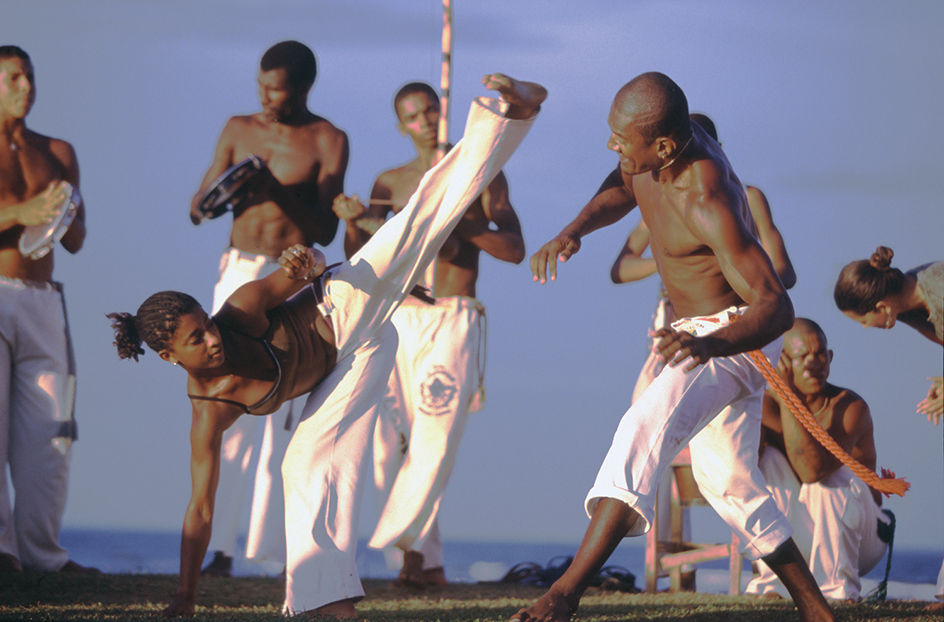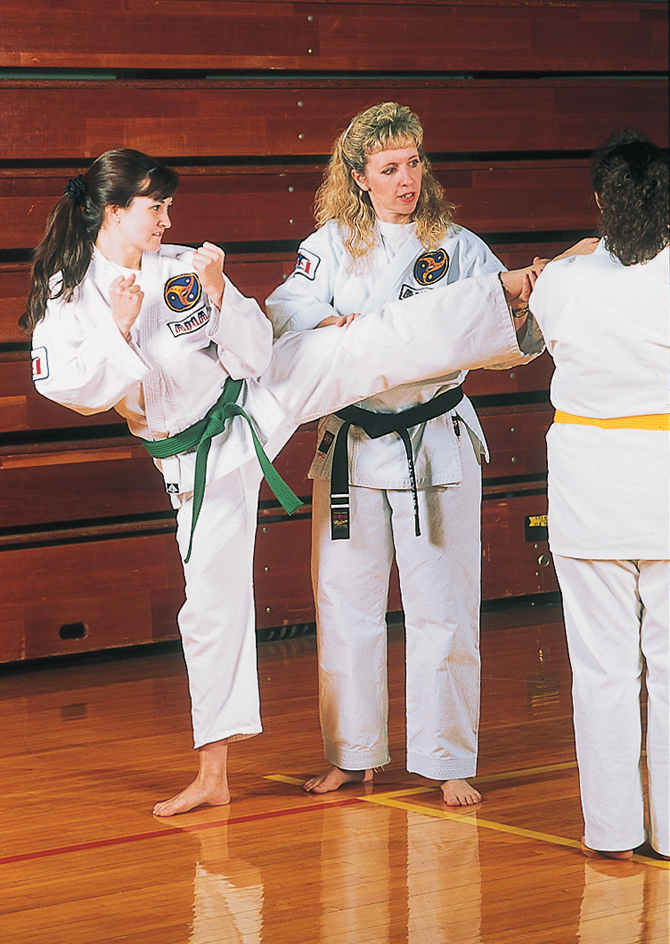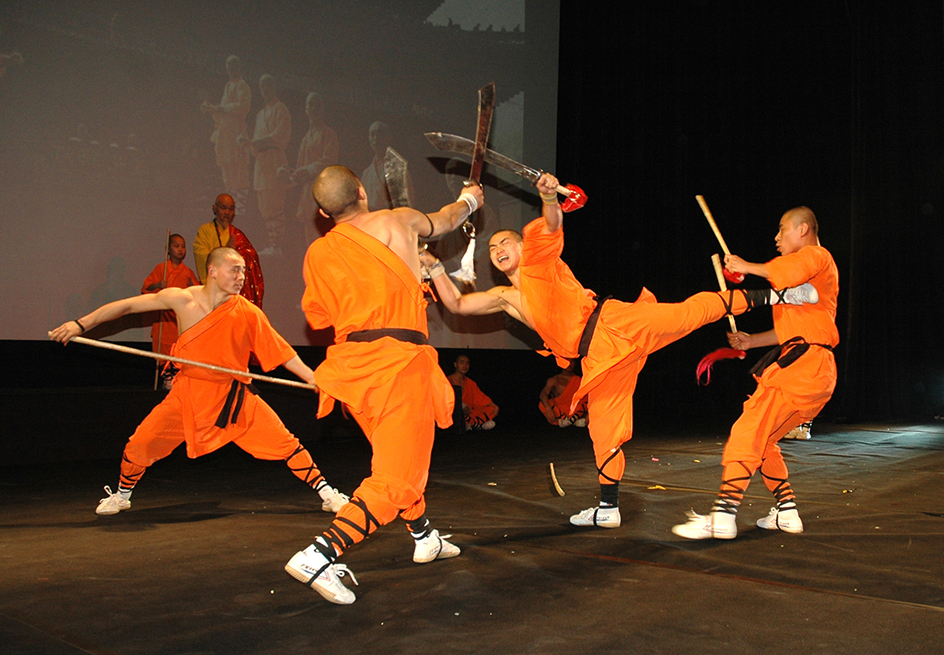Martial, << MAHR shul, >> arts is a general term for fighting arts. There are hundreds of martial arts, each in a specific style or system. Many of the martial arts practiced today originated in China, Japan, or Korea. However, martial arts exist throughout the world.
Almost every human culture has created some kind of martial art. Many of these arts are known mostly in certain regions or ethnic communities. Such arts include, for instance, a form of stick fighting practiced by the Zulu people of South Africa and a style of wrestling practiced in Mongolia. Other martial arts have worldwide popularity. For instance, the dancelike martial art called capoeira << kah poo AY rah >> from Brazil, and the stick-fighting art of eskrima << ehs KREEM mah >> , which began in the Philippines, have gained international followings. Similarly, a group of systems with the overall name of silat << SEE laht >> spread from Indonesia and Malaysia to many other countries.

The martial arts can generally be divided into four categories: (1) percussive, (2) nonpercussive, (3) mixed, and (4) armed arts. In percussive martial arts, the fighters primarily strike with their hands and feet. Examples of percussive martial arts include karate << kuh RAH tee or kuh rah TAY >> , which developed on the island of Okinawa (now part of Japan), and taekwondo << ty kwahn DOH or teh gwahn DOH >> , which developed in Korea. In nonpercussive arts, such as the Japanese arts of judo and aikido << eye KEE doh >> , contestants throw the opponent, lock arms or other body parts, or otherwise neutralize the opponent without necessarily striking. In mixed arts, the contestants strike, throw, and lock. Armed arts, such as kendo from Japan and eskrima, focus on the use of a weapon. Armed arts teach strikes and throws partly as an alternative in case the participant loses or breaks the weapon.

Combat sports—sometimes called martial sports—are related to martial arts. Combat sports include boxing, kickboxing, mixed martial arts, wrestling, judo, and taekwondo competitions. A chief difference between combat sports and martial arts is the way they are presented. Martial arts, in theory, can be learned by almost anyone, given enough time. Combat sports tend to focus on the rapid development of gifted athletes.
Chinese martial arts
are often called kung fu << kuhng foo >> . This term became widely known through motion pictures made in Hong Kong in the early 1970’s and American television programs. The term kung fu, also spelled gongfu, means skill or hard work. In the modern Chinese writing system, the term for martial arts is wushu << woo shoo >> .

Although the Chinese martial arts are ancient in origin, most of the systems used today have only a few hundred years of documented history. Popular Chinese martial art systems include Shaolin << shah oh LIHN >> kung fu, known for strength, speed, and acrobatic legwork; t’ai chi ch’uan << ty jee chwahn >> , also spelled taijiquan, which emphasizes gentle force and inner harmony; and assorted wrestling styles. Chinese martial arts are commonly used for self defense, for health and exercise, and in theatrical productions.
Japanese martial arts
are usually divided into “old systems” and “modern martial ways.” The old systems, called bujutsu << boo JUHT soo >> , were taught in the years when warriors known as samurai had great influence over Japanese life. The modern martial ways, called budo << boo doh >> , developed after 1868, when the Meiji Restoration reestablished the emperor as the head of the Japanese government. Because the older systems taught specific techniques, their names often include the suffix jutsu, which means art or technique. Examples include kenjutsu (art of the sword) and jujutsu, also spelled jujitsu (flexible art).
Generally, students learned the older systems in schools from teachers who expected a pledge of secrecy concerning the methods they taught. The concept of loyalty to the student’s school or clan was an important part of instruction. Beginning in the late 1800’s, the Japanese developed (modern martial arts, pronounced gendai budo << jehn dy boo doh >> ) because martial arts as practiced by the samurai were no longer needed. Today, Japanese martial arts are usually presented to encourage physical, moral, and spiritual development.
Japanese martial arts commonly practiced outside Japan include aikido, judo, karate-do, kendo, ninpo (or ninjutsu), and shorinji kempo. In Japan, the wrestling style sumo is usually described as a national sport rather than a martial art. Judo is a sport in the Summer Olympic Games. Karate was added as a sport for the 2020 Summer Olympic Games. The 2020 Summer Olympic Games were held in 2021 due to the COVID-19 pandemic.
Korean martial arts
include armed systems, unarmed systems, and modern sports. The oldest system is ssireum << sihr ee uhm >> , a form of wrestling that is similar to Japanese sumo. In terms of participation, the most popular Korean martial art is taekwondo, known for its wide range of kicks. Historians believe the roots of taekwondo date back at least to the Silla Dynasty (A.D. 668-935). Some martial arts schools were unified under the name taekwondo in the 1950’s. During the 1950’s and 1960’s, taekwondo became a popular international sport. It became an Olympic event in 2000.
Central and South Asian martial arts.
In parts of central Asia, martial arts reflect the culture of particular areas. For example, people in some parts of Nepal wrestle in the Mongolian style, and people in other parts of the country wrestle in the North Indian style. Modern martial arts of central and southern Asia include Muay Thai << moo ay ty >> , a style of kickboxing from Thailand; Turkish oil wrestling, so named because the wrestlers cover themselves in olive oil; and gatka, a form of stick fighting associated with the Sikh religion of India.
European martial arts
thrived until the 1600’s, when interest declined because modern firearms replaced the arts as weapons in battle. But some of these martial arts survive as part of the cultural history of certain areas. Examples include glima << GLEE muh >> wrestling in Iceland and backhold wrestling in Scotland. Descendants of several European arts have become modern sports, such as boxing, freestyle wrestling, and fencing. In addition, enthusiasts have tried to reconstruct some of the historical European martial arts of the late medieval and Renaissance periods, from about the 1300’s to the 1600’s. They generally use reprints of old fencing manuals as their guides.
Mixed martial arts (MMA)
is based on unarmed combat between two opponents. MMA has roots dating back many years, but it developed into a popular combat sport during the early 1990’s.
In early MMA competitions, specialists representing a wide variety of styles fought against each other. In these contests, experts in Brazilian jiu-jitsu—an adaptation of Japanese jujutsu that involves a wide range of ground fighting techniques—had great success. Later, MMA gradually evolved into its own unique style, combining grappling and striking. By the early 2000’s, MMA competitions rivaled boxing matches in popularity, and the leading MMA fighters became internationally famous.
